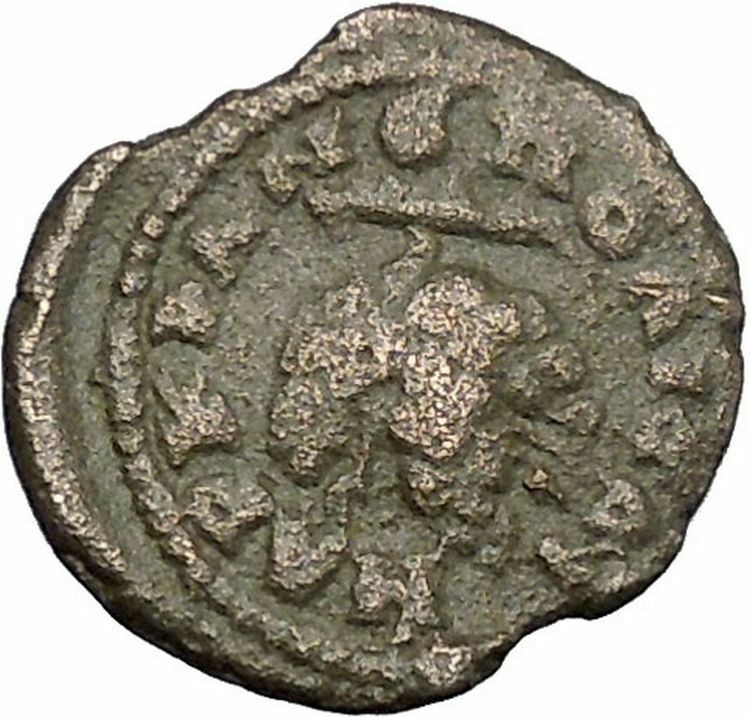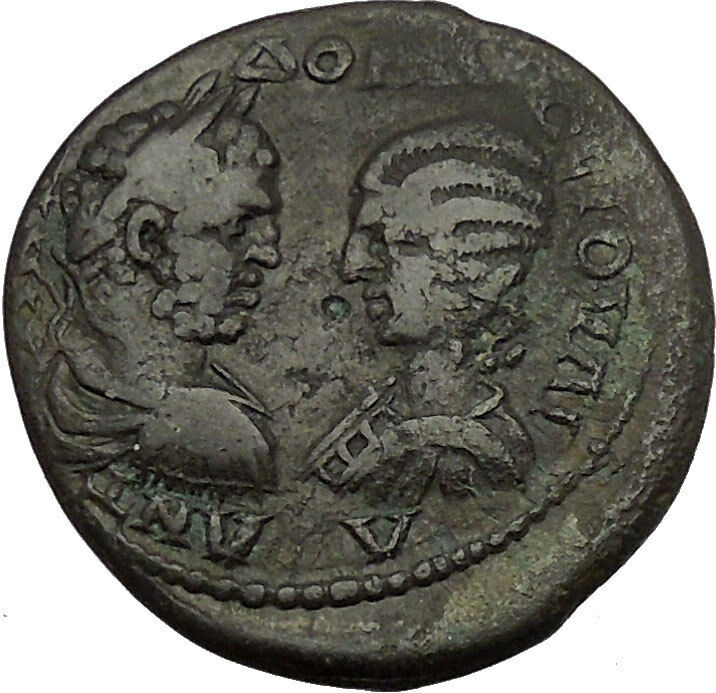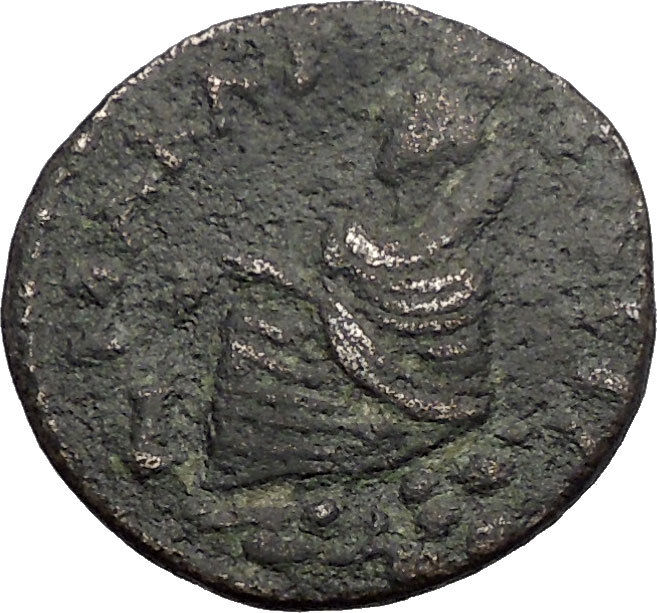|
Marcus Ambibulus prefect of Judaea under Roman Emperor Augustus, ruling 9-12 A.D.
Bronze Prutah 15mm (1.18 grams) from the mint of Jerusalem 8-11 A.D.
Reference: Hendin 1329-1331 (5th Edition)
KAICAPOC (of Caesar), ear of grain curved to right
LΛΘ or LM or LMA (year 39/40/41 = 8-11 A.D.) in fields; eight-branched palm tree bearing two bunches of dates.
Marcus Ambibulus was Roman Prefect of the province of Judaea and Samaria. Originally a cavalry officer, he succeeded Coponius in 9 AD and ruled the area until 13 AD when he was succeeded by Annius Rufus. Josephus noted his tenure in Antiquities 18.31.
Roman Procurator coinage were coins issued by the Roman Procurators and Prefects of the province of Judaea between 6 – 66 A.D. They minted only one denomination and size, the bronze prutah. Not all of the Procurators issued coinage. The procurators / prefects of the province of Judaea under the Romans that issued coins were Coponius, Marcus Ambibulus, Valerius Gratus, Pontius Pilate, Antonius Felix and Porcius Festus. The last three Procurators Lucceius Albinus, Gessius Florus and Marcus Antonius Julianus didn’t issue any coins as the tidings of the First Jewish-Roman War was in the air brewing during emperor Nero’s reign and the leaders of the revolt started issuing their own coins, for what is known as the Jewish War.
You are bidding on the exact item pictured, provided with a Certificate of Authenticity and Lifetime Guarantee of Authenticity.
Judea (Hebrew: יהודה, Standard Yehuda Tiberian Yehûḏāh; Arabic: يهودا; Greek: Ἰουδαία; Latin: IVDAEA), sometimes spelled in its original Latin forms of Judæa, Judaea or Iudaea to distinguish it from the geographical region of Judea, was a Roman province that incorporated the geographical regions of Judea, Samaria, and Idumea, and which extended over parts of the former regions of the Hasmonean and Herodian kingdoms of Israel. It was named after Herod Archelaus’s Tetrarchy of Judea, of which it was an expansion, the latter name deriving from the Kingdom of Judah of the 6th century BCE.
Rome’s involvement in the area dated from 63 BCE, following the end of the Third Mithridatic War, when Rome made Syria a province. In that year, after the defeat of Mithridates VI of Pontus, the proconsul Pompeius Magnus (Pompey the Great) sacked Jerusalem and entered the Jerusalem Temple. Subsequently, during the 1st century BCE, the Herodian Kingdom was established as a Roman client kingdom and then in 6 CE parts became a province of the Roman Empire.
Judea province was the scene of unrest at its founding during the Census of Quirinius and several wars were fought in its history, known as the Jewish-Roman wars. The Temple was destroyed in 70 as part of the Great Jewish Revolt resulting in the institution of the Fiscus Judaicus, and after Bar Kokhba’s revolt (132-135 CE), the Roman Emperor Hadrian changed the name of the province to Syria Palaestina and Jerusalem to Aelia Capitolina, which certain scholars conclude was done in an attempt to remove the relationship of the Jewish people to the region.
Relations with Hasmonean and Herodian dynasties
The first intervention of Rome in the region dates from 63 BCE, following the end of the Third Mithridatic War, when Rome made a province of Syria. After the defeat of Mithridates VI of Pontus, Pompey (Pompey the Great) remained there to secure the area.
The region at the time was not a peaceful place. The Queen of Judaea Salome Alexandra had recently died and her sons, Hyrcanus II and Aristobulus II, divided against each other in a civil war.
In 63 BCE, Aristobulus was besieged in Jerusalem by his brother’s armies. He sent an envoy to Marcus Aemilius Scaurus, Pompey’s representative in the area. Aristobulus offered a massive bribe to be rescued, which Pompey promptly accepted. Afterwards, Aristobulus accused Scaurus of extortion. Since Scaurus was Pompey’s brother in law and protégée, the general retaliated by putting Hyrcanus in charge of the kingdom as Ethnarch and High Priest, but he was denied the title of King.
When Pompey was defeated by Julius Caesar, Hyrcanus was succeeded by his courtier Antipater the Idumaean, also known as Antipas, as the first Roman Procurator. In 57-55 BCE, Aulus Gabinius, proconsul of Syria, split the former Hasmonean Kingdom of Israel into five districts of the Sanhedrin.
Both Caesar and Antipater were killed in 44 BCE, and the Idumean Herod the Great, Antipater’s son, was designated “King of the Jews” by the Roman Senate in 40 BCE. He didn’t gain military control until 37 BCE. During his reign the last representatives of the Maccabees were eliminated, and the great port of Caesarea Maritima was built. He died in 4 BCE, and his kingdom was divided among three of his sons, who became tetrarchs (“rulers of a quarter part”, or in this case rather of “thirds”). One of these tetrarchies was Judea corresponding to the territory of the tribe of Judah, plus Samaria and Idumea. Herod’s son Herod Archelaus, ruled Judea so badly that he was dismissed in 6 CE by the Roman emperor Augustus, after an appeal from his own population. Another, Herod Antipas, ruled as tetrarch of Galilee and Perea from 4 BCE to 39 CE, being then dismissed by Caligula. The third tetrarch, Herod’s son Philip, ruled over the northwestern part of his father’s kingdom.
Judea as Roman province
In 6 CE Judea became part of a larger Roman province, called Iudaea, which was formed by combining Judea proper (biblical Judah) with Samaria and Idumea (biblical Edom). Even though Iudaea is simply derived from the Latin for Judea, many historians use it to distinguish the Roman province from the previous territory and history. Iudaea province did not include Galilee, Gaulanitis (the Golan), nor Peraea or the Decapolis. Its revenue was of little importance to the Roman treasury, but it controlled the land and coastal sea routes to the bread basket Egypt and was a border province against the Parthian Empire because of the Jewish connections to Babylonia (since the Babylonian exile). The capital was at Caesarea, not Jerusalem, which had been the capital for King David, King Hezekiah, King Josiah, the Maccabees and Herod the Great. Quirinius became Legate (Governor) of Syria and conducted the first Roman tax census of Syria and Iudaea, which was opposed by the Zealots. Iudaea was not a Senatorial province, nor exactly an Imperial province, but instead was a “satellite of Syria” governed by a prefect who was a knight of the equestrian order (as was Roman Egypt), not a former consul or praetor of senatorial rank. Pontius Pilate was one of these prefects, from 26 to 36 CE. Caiaphas was one of the appointed High Priests of Herod’s Temple, being appointed by the Prefect Valerius Gratus in 18. Both were deposed by the Syrian Legate Lucius Vitellius in 36 CE.
The ‘Crisis under Caligula’ (37-41) has been proposed as the first open break between Rome and the Jews.
Between 41 and 44 CE, Iudaea regained its nominal autonomy, when Herod Agrippa was made King of the Jews by the emperor Claudius, thus in a sense restoring the Herodian Dynasty, though there is no indication Iudaea ceased to be a Roman province simply because it no longer had a prefect. Claudius had decided to allow, across the empire, procurators, who had been personal agents to the Emperor often serving as provincial tax and finance ministers, to be elevated to governing magistrates with full state authority to keep the peace. He elevated Iudaeas’s procurator whom he trusted to imperial governing status because the imperial legate of Syria was not sympathetic to the Judeans. Following Agrippa’s death in 44 CE, the province returned to direct Roman control for a short period. Agrippa’s son Marcus Julius Agrippa was designated King of the Jews in 48. He was the seventh and last of the Herodians. From 70 CE until 135 CE, Iudaea’s rebelliousness required a governing Roman legate capable of commanding legions. Because Agrippa II maintained loyalty to the Empire, the Kingdom was retained until he died, either in 93/94 or 100, when the area returned to complete, undivided Roman Empire control.
Judaea was the stage of two, possibly three major rebellions against Roman rule:
- 66-70 CE – first rebellion, ending in the siege of Jerusalem and the destruction of Herod’s Temple (see Great Jewish Revolt, Josephus)
- 115-117 CE – second rebellion, called Kitos War; Judaea’s role in it is disputed though, as it played itself out mainly in the Jewish diaspora and there are no fully trustworthy sources on Judaea’s participation in the rebellion, nor is there any archaeological way of distinguishing destruction levels of 117 CE from those of the large Bar Kokhba revolt of just a decade and a half later.
- 132-135 CE – third rebellion, Bar Kokhba’s revolt
Following the suppression of Bar Kokhba’s revolt, the emperor Hadrian changed the name of the province to Syria Palaestina and Jerusalem became Aelia Capitolina which Hayim Hillel Ben-Sasson states was done to erase the historical ties of the Jewish people to the region.
Under Diocletian (284-305) the region was divided into Palaestina Prima (Judea, Samaria, Idumea, Peraea and the coastal plain with Caesarea as capital), Palaestina Secunda (Galilee, Decapolis, Golan with Beth-shean as capital) and Palaestina Tertia (the Negev with Petra as capital).
|










